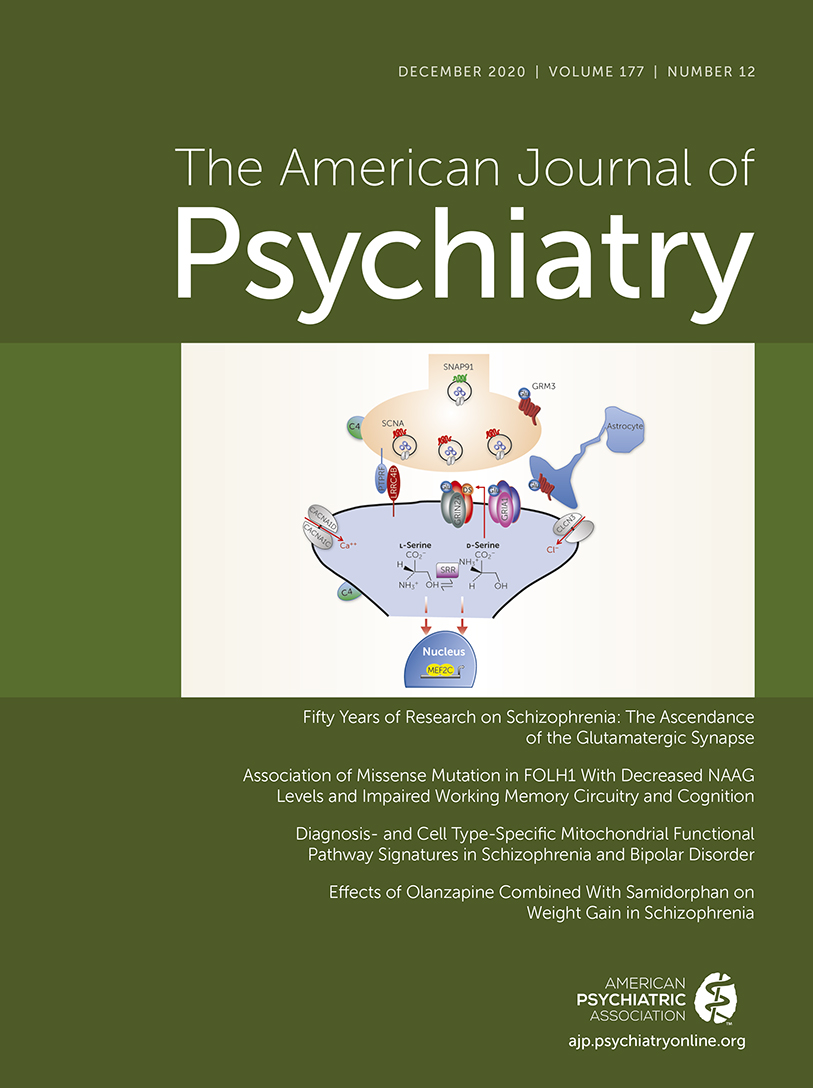Antipsychotic medications remain the mainstay of the pharmacological treatment of people with schizophrenia. They are relatively effective for the treatment of the positive symptoms of the illness and the prevention of relapse and rehospitalization, but have limited treatment benefits for the two illness components that are most associated with functional impairments: negative symptoms and cognitive impairments (
1–
4). Almost all antipsychotic medications work through dopamine D
2 receptor antagonism and exhibit roughly equivalent efficacy (
5). The one notable exception is clozapine, which is the only antipsychotic medication that has been approved for people with treatment-resistant schizophrenia (
1). There is also some evidence to suggest that olanzapine may be more effective than other first- and second-generation antipsychotic medications (
6). However, olanzapine is associated with significant weight gain and the development of various metabolic abnormalities, which limits the use of this potentially more effective agent. The development of an effective strategy to minimize olanzapine-induced weight gain and metabolic abnormalities would have the potential benefit of allowing for increased use of this agent.
The study by Correll and colleagues (
7) in this issue of the
Journal addresses a novel approach to reducing olanzapine-induced weight gain. Samidorphan is a µ-opioid receptor antagonist and a partial agonist at the ĸ- and δ-opioid receptors (
8). The µ-, ĸ-, and δ-opioid receptors have been implicated in the regulation of weight gain and metabolism (
9–
11). In order to test the hypothesis that the addition of samidorphan to olanzapine would significantly reduce or prevent olanzapine-associated weight gain, the authors conducted a 24-week, double-blind, placebo-controlled randomized clinical trial in people with schizophrenia, which compared olanzapine (10–20 mg) plus a fixed dose of samidorphan (10 mg) to olanzapine plus placebo. The co-primary outcome measures were percent change from baseline in weight and the percentage of people who gained more than 10% of their baseline body weight. The key secondary endpoint was the percentage of people who gained more than 7% of their baseline weight. Other outcome measures included waist circumference and various metabolic indices.
The authors found that combined olanzapine/samidorphan compared with olanzapine/placebo resulted in significantly less weight gain, fewer participants who gained >10% or >7% of their baseline weight, and a smaller increase in waist circumference. However, somewhat surprisingly, there was no significant difference between the groups on metabolic measures, including fasting glucose, cholesterol (total, HDL, and LDL), or triglyceride levels and nonfasting HbA1c. The study had multiple strengths, including a large sample size, frequent assessments, and adequate trial duration. There was a relatively large proportion and similar rate of dropout in both groups; the provision of data on time to discontinuation would have been helpful in letting the reader know whether the duration of exposure to the two treatments was similar. Although there is always the possibility that a longer trial duration could have allowed for greater separation between the two groups, any potential benefit of a longer trial duration may have been offset by even greater dropout rates. The other design feature of interest was the decision to restrict the study to participants with a baseline body mass index in the range of 18 to 30. As the authors note, in light of the fact that the participants had been ill for approximately 20 years, the sample may represent a relatively unique subgroup of people with schizophrenia who are not particularly sensitive to the metabolic effects of antipsychotic medications. Further studies with a broader spectrum of participants will be required to see whether this is an important factor in the efficacy profile of the experimental intervention.
In light of the absence of any particularly effective treatments for antipsychotic-induced weight gain, other than the initial prevention of weight gain or switching antipsychotics (
1), the ability of samidorphan to reduce olanzapine-induced weight gain is an important finding. However, the apparent lack of effect on the various metabolic measures raises the question of what the ultimate clinical significance is of the modest effect on weight gain produced by samidorphan. In the Discussion section, the authors suggest that olanzapine-induced metabolic abnormalities may not always be related to weight gain but may represent a direct effect of olanzapine on metabolism. There is evidence from preclinical studies that olanzapine may affect food preference, with olanzapine-treated animals shifting from a protein-rich to a fat-rich diet (
12). Alternatively, olanzapine may have direct effects on insulin secretion from the pancreas and/or alter the sensitivity of insulin receptors, leading to the development of insulin resistance (
13). The absence of an effect of samidorphan on these metabolic actions of olanzapine would raise concerns about the range of beneficial effects of add-on samidorphan.
The other major issue raised by the study is whether there is any particular advantage of the olanzapine/samidorphan combination over the use of other agents that might affect metabolism (e.g., metformin). Despite the authors’ criticisms of previous studies, metformin has been shown in several studies to significantly reduce antipsychotic-induced weight gain and metabolic indices, especially glucose levels (
14,
15). There is less evidence to support the utility of metformin for the prevention of olanzapine-induced weight gain, although this issue has not been as extensively studied (
16,
17). If the olanzapine/samidorphan combination is to have an important place in our treatment armamentarium, then a direct comparison with metformin should be conducted. The standard that new treatments should be at least as effective, if not more effective, than currently available interventions should also apply to treatments of adverse effects, especially since the fixed combination of olanzapine/samidorphan will limit the flexibility of olanzapine dosing for those who require either less or more olanzapine than the U.S. Food and Drug Administration’s approved range of maintenance dosages.
Finally, the investigation of the potential utility of the olanzapine/samidorphan combination reflects the ongoing search for a pharmacological treatment for schizophrenia and related disorders that offers both potent efficacy and minimal side effects. Over the past two decades, several new antipsychotic medications have been introduced for the treatment of schizophrenia and related disorders that have significantly more benign metabolic profiles than olanzapine (e.g., aripiprazole, asenapine, brexpiprazole, cariprazine, lumateperone, lurasidone). However, none of these agents have distinguished themselves, with respect to efficacy, from olanzapine and other non-clozapine antipsychotic medications (
18). The two newest agents, cariprazine and lumateperone, have relatively unique pharmacological mechanisms (
19,
20), but whether they will have equal or superior efficacy compared with olanzapine and reduce the need for the use of olanzapine remains to be determined.

